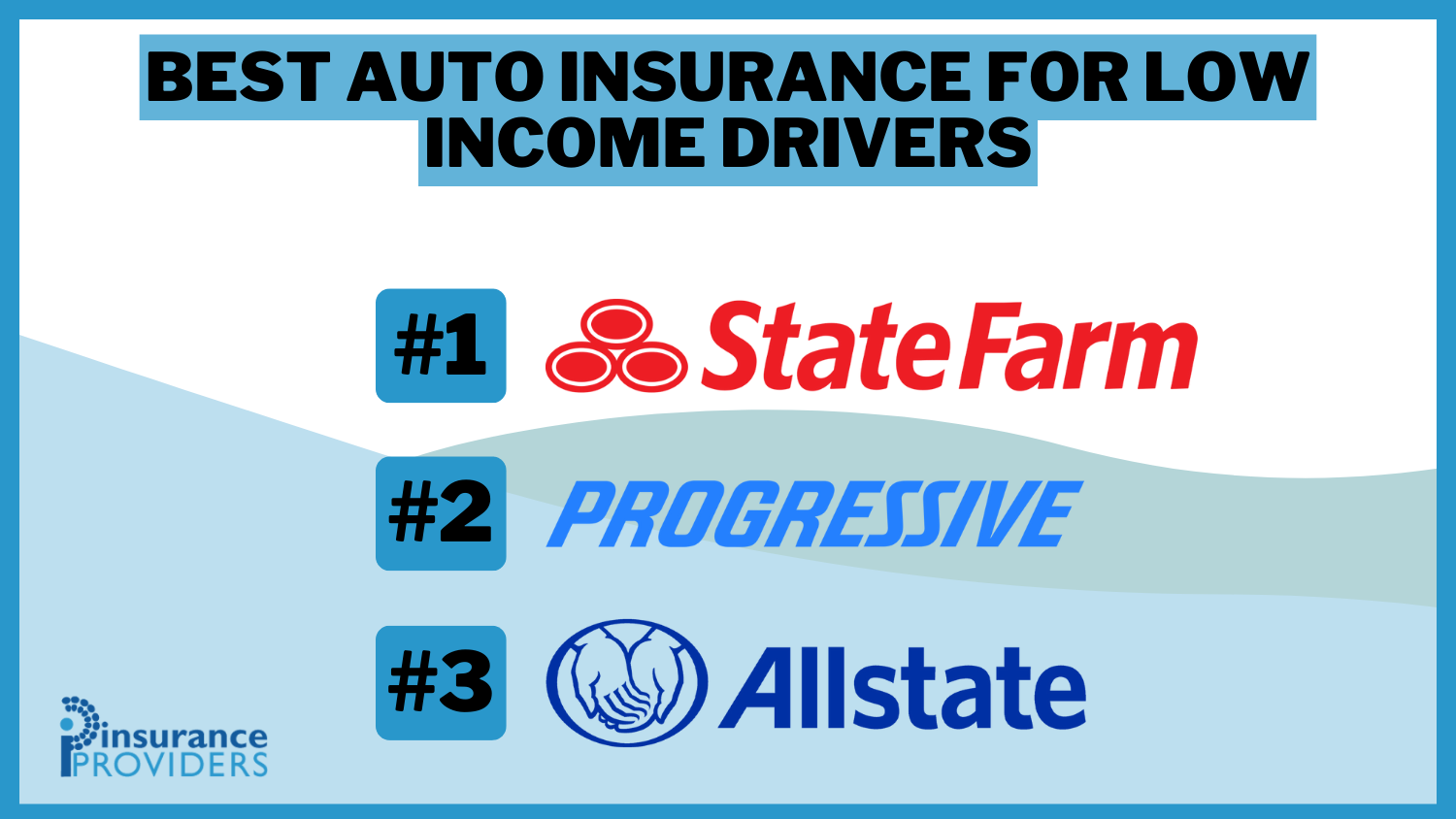Best Auto Insurance for Low Income Drivers in 2025 (Top 10 Companies)
Discover why State Farm, Progressive, and Allstate excel as the best car insurance companies for low income drivers. With competitive rates, diverse discounts, and flexible payment options, these companies provide comprehensive and affordable coverage for budget-conscious individuals.
Read more Secured with SHA-256 Encryption





Table of Contents
Table of Contents


Licensed Insurance Agent
Chris is the founder of Abrams Insurance Solutions and Marcan Insurance, which provide personal financial analysis and planning services for families and small businesses across the U.S. His companies represent nearly 100 of the top-rated insurance companies. Chris has been a licensed life and health insurance agent since 2009 and has active insurance licenses in all 50 U.S. states and D.C. Chr...
Chris Abrams


Licensed Insurance Agent
Daniel Walker graduated with a BS in Administrative Management in 2005 and has run his family’s insurance agency, FCI Agency, for over 15 years (BBB A+). He is licensed as an insurance agent to write property and casualty insurance, including home, life, auto, umbrella, and dwelling fire insurance. He’s also been featured on sites like Reviews.com and Safeco. To ensure our content is accura...
Daniel Walker
Updated March 2024
 13,283 reviews
13,283 reviewsCompany Facts
Average Monthly Rate For Good Drivers
A.M. Best Rating
Complaint Level
Pros & Cons
 13,283 reviews
13,283 reviews 11,638 reviews
11,638 reviewsCompany Facts
Average Monthly Rate For Good Drivers
A.M. Best Rating
Complaint Level
Pros & Cons
 11,638 reviews
11,638 reviewsExamine the best car insurance companies for low income drivers like State Farm, Progressive, and Allstate. With competitive rates, extensive discounts, and flexible payment options, State Farm offers comprehensive yet affordable protection for vehicles.
- Top insurance companies like State Farm, Progressive, and Allstate offer competitive rates and tailored coverage options for low-income drivers.
- Low-income drivers face challenges such as limited financial resources and high premium rates.
- Maintaining a clean driving record, choosing a lower-cost vehicle, and taking advantage of available discounts are key strategies to lower car insurance costs for low-income individuals.
Delve into this article for an insightful breakdown, discovering which company excels in providing the most advantageous rates for your unique profile. Whether you’re prioritizing a stellar driving record, seeking full coverage, or aiming for affordability, our data-driven insights empower you to make informed decisions and secure the ideal insurance fit.
Our Top 10 Best Companies: Best Auto Insurance for Low Income Drivers
| Company | Rank | See Pros/Cons | Low-Income Driver Discount | Multi-Vehicle Discount | Best For |
|---|---|---|---|---|---|
| #1 | State Farm | Up To 12% | Up To 15% | 24/7 Support | |
| #2 | Progressive | Up To 15% | Up To 17% | Vanishing Deductible | |
| #3 | Allstate | Up To 10% | Up To 18% | Safe-Driving Discounts | |
 | #4 | Liberty Mutual | Up To 8% | Up To 14% | Multi-Policy Discounts |
| #5 | Farmers | Up To 9% | Up To 16% | Bundle Discounts | |
| #6 | Esurance | Up To 11% | Up To 15% | Customizable Policies | |
 | #7 | Nationwide | Up To 10% | Up To 13% | Comprehensive Coverage |
 | #8 | Travelers | Up To 7% | Up To 12% | Local Agents |
| #9 | American Family | Up To 8% | Up To 14% | Policy Options | |
| #10 | Safeco | Up To 9% | Up To 16% | Online Convenience |
#1 – State Farm: 24/7 Support
State Farm stands out as a frontrunner for low-income drivers with its 24/7 support, showcasing a commitment to financial flexibility and customer assistance.Ty Stewart Licensed Life Insurance Agent
Pros
- Up to 12% low-income driver discount: Providing cost savings for low-income drivers.
- Up to 15% multi-vehicle discount: Incentives for policyholders with multiple vehicles.
- Extensive 24/7 customer support for immediate assistance: Round-the-clock assistance for customer convenience.
Cons
- Low-income driver discount, while good, may be surpassed by some competitors: The discount, though beneficial, may not be the highest available.
- Premium rates may be slightly higher than budget-focused insurers: Pricing might be comparatively higher for budget-focused customers.
Read more: State Farm Auto Insurance Review
Free Auto Insurance Comparison
Compare Quotes From Top Companies and Save
Secured with SHA-256 Encryption
#2 – Progressive: Vanishing Deductible
Pros
- Up to 15% low-income driver discount: Significant cost savings for low-income drivers.
- Up to 17% multi-vehicle discount: Incentives for policyholders with multiple vehicles.
- Innovative vanishing deductible feature for added savings: Unique feature contributing to potential savings.
Cons
- While competitive, the low-income driver discount could be higher: The discount, though good, may have room for improvement.
- Premiums might increase after the first policy term: Potential premium hikes after the initial term.
Read more: Progressive Auto Insurance Review
#3 – Allstate: Safe-Driving Discounts
Pros
- Up to 10% low-income driver discount: Offering savings for low-income drivers.
- Up to 18% multi-vehicle discount: Incentives for policyholders with multiple vehicles.
- Strong emphasis on safe-driving discounts for enhanced savings: Prioritizing safe-driving behaviors for potential cost reductions.
Cons
- The low-income driver discount, though present, might be considered moderate: The discount, while available, may not be the highest.
- Some customers report higher premium increases after filing claims: Potential premium increases post-claims.
Read more: Allstate Auto Insurance Review
#4 – Liberty Mutual: Multi-Policy Discounts
Pros
- Up to 8% low-income driver discount: Providing savings for low-income drivers.
- Up to 14% multi-vehicle discount: Incentives for policyholders with multiple vehicles.
- Attractive multi-policy discounts for comprehensive coverage: Additional savings for bundling policies.
Cons
- Low-income driver discount may be comparatively lower: The discount, though present, might be on the lower side.
- Some policyholders report occasional delays in claims processing: Potential delays in claims processing reported by some customers.
Free Auto Insurance Comparison
Compare Quotes From Top Companies and Save
Secured with SHA-256 Encryption
#5 – Farmers: Bundle Discounts
Pros
- Up to 9% low-income driver discount: Providing cost savings for low-income drivers.
- Up to 16% multi-vehicle discount: Incentives for policyholders with multiple vehicles.
- Bundle discounts offer additional savings for policyholders: Additional savings for bundling policies.
Cons
- Low-income driver discount is moderate compared to some competitors: The discount, while good, may not be the highest available.
- Customer service response times may vary based on location: Varied customer service response times based on location.
Read more: Farmers Auto Insurance Review
#6 – Esurance: Customizable Policies
Pros
- Up to 11% low-income driver discount: Significant cost savings for low-income drivers.
- Up to 15% multi-vehicle discount: Incentives for policyholders with multiple vehicles.
- Customizable policies allow flexibility based on individual needs: Tailored coverage options for personalized preferences.
Cons
- Low-income driver discount, while competitive, might not be the highest available: The discount, though good, may have room for improvement.
- Some customers report occasional challenges with online account management: Occasional challenges reported with online account management.
Read more: Esurance Auto Insurance Review
#7 – Nationwide: Comprehensive Coverage
Pros
- Up to 10% low-income driver discount: Providing savings for low-income drivers.
- Up to 13% multi-vehicle discount: Incentives for policyholders with multiple vehicles.
- Nationwide offers comprehensive coverage options for various needs: Diverse coverage options for comprehensive protection.
Cons
- Low-income driver discount is competitive but may not be the highest: The discount, while good, may not be the highest available.
- Premiums might be slightly higher for policyholders with less-than-perfect driving records: Potential slightly higher premiums for certain driving records.
Free Auto Insurance Comparison
Compare Quotes From Top Companies and Save
Secured with SHA-256 Encryption
#8 – Travelers: Local Agents
Pros
- Up to 7% low-income driver discount: Providing savings for low-income drivers.
- Up to 12% multi-vehicle discount: Incentives for policyholders with multiple vehicles.
- Local agents provide personalized assistance and support: In-person support for personalized assistance.
Cons
- Low-income driver discount is relatively modest: The discount, while present, is not the highest.
- Some policyholders report longer claims processing times: Claims processing times may be longer compared to other insurers.
Read more: Travelers Auto Insurance Review
#9 – American Family: Policy Options
Pros
- Up to 8% low-income driver discount: Providing savings for low-income drivers.
- Up to 14% multi-vehicle discount: Incentives for policyholders with multiple vehicles.
- American Family offers a range of policy options for personalized coverage: Diverse policy options for personalized insurance coverage.
Cons
- Low-income driver discount is competitive but may not be the highest: The discount, though good, may not be the highest available.
- Some customers report occasional challenges with billing and payment processing: Occasional challenges reported in billing and payment processing.
Read more: American Family Auto Insurance Review
Free Auto Insurance Comparison
Compare Quotes From Top Companies and Save
Secured with SHA-256 Encryption
Navigating Affordability: Decoding Car Insurance Rates for Low-Income Drivers
The table provides a comprehensive overview of average monthly car insurance rates for low-income drivers across various insurance companies. It delineates the costs associated with both full coverage and minimum coverage policies offered by prominent insurance providers.
Average Monthly Auto Insurance Rates for Low Income Drivers
| Insurance Company | Full Coverage | Minimum Coverage |
|---|---|---|
| State Farm | $86 | $33 |
| Progressive | $105 | $39 |
| Allstate | $160 | $61 |
| Liberty Mutual | $174 | $68 |
| Farmers | $139 | $44 |
| Esurance | $114 | $46 |
| Nationwide | $115 | $44 |
| Travelers | $99 | $37 |
| American Family | $117 | $44 |
| Safeco | $71 | $27 |
As affordability is a crucial factor for individuals with limited financial means, analyzing the specific coverage rates becomes pivotal in helping low-income drivers make informed decisions about their car insurance choices. Examining the coverage rates, it is evident that the monthly premiums for both full coverage and minimum coverage policies vary significantly among the listed insurance companies.
State Farm stands out with the lowest rates for both full and minimum coverage, offering a competitive $86 and $33 respectively. On the other end of the spectrum, Liberty Mutual presents higher premiums at $174 for full coverage and $68 for minimum coverage.
This disparity underscores the importance of shopping around and comparing rates, especially for low-income drivers who may be particularly sensitive to these costs.
Additionally, the table reveals nuances in pricing strategies among insurers, emphasizing the need for consumers to carefully assess their individual coverage needs and financial constraints when selecting an car insurance provider.
Understanding Car Insurance
Car insurance is a contract between you and an insurance company that protects you financially in the event of an accident or damages to your vehicle. It provides coverage for liability, personal injury, property damage, and medical expenses. Additionally, it offers protection against theft and vandalism.
Why is car insurance important? Car insurance is not only a legal requirement in most states but also provides financial security. In the event of an accident, insurance can help cover expensive medical bills, vehicle repairs, and potential legal expenses.
When it comes to car insurance, there are several important factors to consider. One of the key aspects is liability coverage. This type of coverage protects you if you are at fault in an accident and cause damage to someone else’s property or injure another person. Without liability coverage, you could be held personally responsible for the costs associated with the accident.
Another important component of car insurance is personal injury protection. This coverage helps pay for medical expenses and lost wages if you or your passengers are injured in an accident, regardless of who is at fault. Personal injury protection can provide much-needed financial support during a difficult time, ensuring that you can focus on recovering without worrying about the financial burden.
Property damage coverage is also a crucial part of car insurance. This coverage helps pay for damages to someone else’s property, such as their vehicle or other structures, if you are at fault in an accident. Without property damage coverage, you could be facing significant out-of-pocket expenses to repair or replace the damaged property.
Medical expenses can quickly add up after an accident, especially if there are serious injuries involved. Car insurance can help alleviate some of the financial strain by covering necessary medical treatments, hospital stays, and rehabilitation services. This coverage can be a lifeline for individuals and families who would otherwise struggle to afford the high costs of medical care.
Aside from the coverage mentioned above, car insurance also offers protection against theft and vandalism. If your vehicle is stolen or damaged due to acts of vandalism, your insurance policy can help cover the cost of repairs or replacement. This can provide peace of mind knowing that you are financially protected against these unfortunate events.
It is important to note that car insurance requirements vary by state. Each state has its own minimum coverage requirements, and it is essential to understand and comply with these regulations. Failing to meet the minimum requirements can result in fines, license suspension, or even legal consequences.
When selecting an car insurance policy, it is crucial to carefully review the coverage options and consider your specific needs. Factors such as the value of your vehicle, your driving record, and your personal circumstances should all be taken into account. By choosing the right coverage, you can ensure that you are adequately protected in the event of an accident or other unforeseen circumstances.
In conclusion, car insurance is not only a legal requirement but also a vital financial protection. It provides coverage for liability, personal injury, property damage, and medical expenses. Additionally, it offers protection against theft and vandalism.
Understanding the different aspects of car insurance and selecting the right coverage can give you peace of mind knowing that you are prepared for any unexpected events on the road.
Factors That Affect Car Insurance Rates
Several factors influence the cost of car insurance premiums. Understanding these factors can help you make informed decisions when purchasing or renewing your policy. Car insurance rates are not fixed and can vary based on a variety of factors. Let’s take a closer look at some of the key factors that can affect your car insurance rates:
Age and Driving Experience
One of the primary factors that insurance companies consider when determining your car insurance rates is your age and driving experience. Young and inexperienced drivers tend to have higher insurance rates due to their higher risk of accidents.
Insurance providers view young drivers as more likely to engage in risky behaviors on the road, which increases the likelihood of accidents. As you gain more experience behind the wheel and maintain a clean driving record, your rates may decrease. This is because insurance companies recognize that experienced drivers are generally more responsible and less likely to be involved in accidents.
Vehicle Type and Usage
The type of vehicle you drive and how you use it can significantly impact your insurance rates. Insurance providers take into account the make, model, and year of your vehicle when calculating premiums. Sports cars and luxury vehicles are usually more expensive to insure due to their higher repair costs.
These types of vehicles are often equipped with advanced technology and expensive parts, making them more costly to repair in the event of an accident. Additionally, if you use your vehicle for business purposes or have a long commute, your rates may be higher. This is because increased mileage and usage increase the likelihood of accidents and the need for repairs.
Driving Record and Claims History
Your driving record and claims history play a significant role in determining your insurance rates. Insurance companies assess the risk you pose as a driver based on your past driving behavior. Accidents, traffic violations, and insurance claims can increase your premiums.
If you have a history of being involved in accidents or receiving traffic citations, insurance providers may consider you a higher risk driver, leading to higher rates. Conversely, a clean driving record and a history of few or no claims can help lower your rates. Insurance companies reward safe drivers who have demonstrated responsible behavior on the road with more affordable premiums.
It’s important to note that these are just a few of the many factors that can influence your car insurance rates. Other factors such as your location, credit score, and even your gender can also impact the cost of your premiums. By understanding these factors and how they affect your rates, you can make informed decisions when selecting an car insurance policy that best fits your needs and budget.
Free Auto Insurance Comparison
Compare Quotes From Top Companies and Save
Secured with SHA-256 Encryption
Challenges Faced by Low Income Drivers in Getting Car Insurance
Low-income drivers often face unique challenges when it comes to obtaining car insurance. These challenges can make it difficult to find affordable coverage that meets their needs. One of the major challenges faced by low-income drivers is the high premium rates.
Insurance companies consider various factors when determining rates, including income. Unfortunately, limited financial resources can make it challenging for low-income drivers to afford these high insurance premiums. With a tight budget, finding a policy that fits within their means becomes a daunting task.
Moreover, another challenge that low-income drivers encounter is limited coverage options. Insurance companies may offer restricted coverage options for individuals with lower incomes. This limitation can leave low-income drivers with fewer choices when it comes to comprehensive coverage and additional benefits.
As a result, they may find themselves with inadequate protection in the event of an accident or other unforeseen circumstances. However, it is important to note that efforts are being made to address these challenges and provide better options for low-income drivers.
Some insurance companies are working towards creating specialized programs and policies specifically designed to cater to the needs of low-income individuals. These programs aim to offer affordable rates and comprehensive coverage options, ensuring that low-income drivers have access to the same level of protection as their counterparts with higher incomes.
Furthermore, various non-profit organizations and government initiatives are also working towards assisting low-income drivers in obtaining car insurance. These programs provide financial assistance or subsidies to help offset the cost of insurance premiums, making it more affordable for low-income individuals to obtain the necessary coverage.
Additionally, some states have implemented alternative insurance options such as state-funded programs or low-cost car insurance plans. These initiatives aim to provide affordable coverage to low-income drivers who may have difficulty obtaining insurance through traditional means.
In conclusion, low-income drivers face numerous challenges when it comes to obtaining car insurance. High premium rates and limited coverage options can make it difficult for them to find affordable and comprehensive coverage.
However, with the introduction of specialized programs, government initiatives, and alternative insurance options, efforts are being made to address these challenges and provide better solutions for low-income drivers.
Case Studies: Empowering Low-Income Drivers With Top Insurance Providers
Case Study 1: State Farm’s Financial Flexibility
Facing financial hardships, low-income driver Ms. Rodriguez found a supportive ally in State Farm. Struggling with unexpected medical expenses, Ms. Rodriguez feared a lapse in coverage. State Farm’s compassionate approach offered a flexible payment plan, enabling her to maintain continuous coverage during challenging times.
The 24/7 customer support further solidified State Farm as a lifeline for Ms. Rodriguez, showcasing the company’s commitment to assisting drivers through financial difficulties.
Case Study 2: Progressive’s Family-Friendly Coverage
For the Mendez family, low-income drivers managing multiple vehicles, Progressive proved to be a reliable partner. Progressive’s vanishing deductible feature became a pivotal aspect, encouraging safe driving habits and gradually reducing the deductible.
With a substantial multi-vehicle discount, Progressive not only ensured cost efficiency but also empowered the Mendez family to prioritize safety. This case underscores Progressive’s commitment to providing tailored, family-friendly solutions for low-income households.
Case Study 3: Allstate’s Safe Driving Incentives
In the pursuit of promoting safe driving practices, low-income driver Mr. Johnson found a valuable collaborator in Allstate. Offering a significant safe-driving discount coupled with a substantial multi-vehicle discount, Allstate not only reduced Mr. Johnson’s premiums but also fostered a culture of safety within his household.
This case exemplifies Allstate’s commitment to empowering low-income drivers through financial accessibility and encouraging responsible driving habits.
Tips to Lower Car Insurance Costs for Low Income Drivers
There are several proactive steps low-income drivers can take to reduce their car insurance costs and ensure affordable coverage.
Maintaining a Clean Driving Record
One of the most effective ways to lower insurance costs is by maintaining a clean driving record. Avoiding accidents and traffic violations demonstrates responsible driving behavior, which can lead to lower premiums.
Choosing a Lower-Cost Vehicle
Selecting a vehicle that is known for its affordability and safety features can help lower insurance premiums. Before purchasing a new vehicle, research its insurance costs to make an informed decision.
Taking Advantage of Discounts
Insurance companies offer various discounts that can significantly reduce premiums. Low-income drivers should inquire about available discounts, such as multi-policy, good student, or low-mileage discounts, to maximize savings.
In conclusion, finding the best car insurance for low-income drivers requires understanding the various factors that influence rates and the challenges faced. By researching top insurance companies with low-income programs, taking steps to minimize risk, and exploring available discounts, low-income drivers can obtain affordable coverage without compromising their financial security.

Frequently Asked Questions
What is the best car insurance for low-income drivers?
The best car insurance for low-income drivers may vary depending on individual circumstances and needs. It is recommended to compare quotes from different insurance providers to find the most affordable and suitable coverage.
What factors should low-income drivers consider when choosing car insurance?
Low-income drivers should consider factors such as the cost of premiums, coverage options, deductibles, and discounts offered by insurance providers. It is important to find a balance between affordability and adequate coverage.
Are there any specific insurance programs or discounts available for low-income drivers?
Some insurance companies or state governments offer specific programs or discounts for low-income drivers. These programs may provide reduced rates or assistance in obtaining affordable coverage. It is advisable to research and inquire with insurance providers or local government agencies for such options.
Can low-income drivers qualify for government assistance for car insurance?
In some cases, low-income drivers may qualify for government assistance programs that help with car insurance costs. These programs vary by state and eligibility criteria. It is recommended to check with local government agencies or social service organizations to explore potential options.
How can low-income drivers save money on car insurance?
Low-income drivers can save money on car insurance by comparing quotes from multiple insurance providers, maintaining a good driving record, choosing higher deductibles, bundling policies (if applicable), and taking advantage of available discounts such as safe driver discounts or low-mileage discounts.
What should low-income drivers do if they cannot afford car insurance?
If low-income drivers are unable to afford car insurance, they should explore options such as state-sponsored insurance programs, government assistance, or seeking guidance from local social service organizations. It is important to comply with the legal requirements of having car insurance, and there may be resources available to help in difficult financial situations.
What challenges do low-income drivers commonly face in securing car insurance?
Low-income drivers often encounter challenges like limited financial resources, leading to higher perceived risk by insurers. They may face difficulties in finding affordable coverage and might need to navigate through options that best suit their budget constraints.
Which car insurance companies are recommended for low-income drivers?
State Farm, Progressive, and Allstate are among the top insurers for low-income drivers, offering competitive rates and various discounts. However, the most suitable choice depends on individual circumstances and coverage needs.
What tips can help low-income drivers lower their insurance costs?
To reduce insurance costs, low-income drivers can consider maintaining a clean driving record, opting for a higher deductible, and exploring discounts offered by insurers. Regularly reviewing and adjusting coverage based on changing circumstances is also a prudent strategy.
Get a FREE Quote in Minutes
Insurance rates change constantly — we help you stay ahead by making it easy to compare top options and save.


